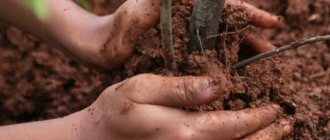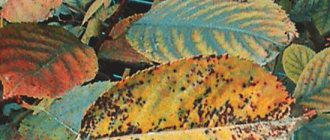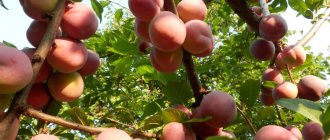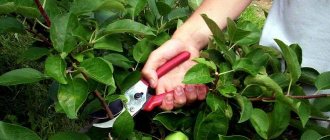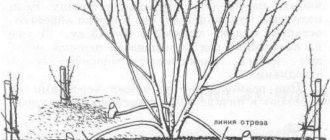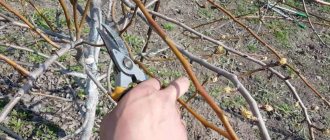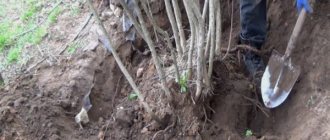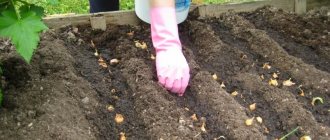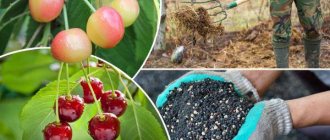Cherry seedlings can be planted throughout the warm period of the year, that is, cherries can be planted in the spring, or in the fall. Each option has its pros and cons. It is believed that due to climatic conditions, autumn planting of fruit trees is preferable for the southern regions. In the central and northern regions, in Siberia and the Urals, spring planting gives a better chance of survival. When determining the optimal timing, it is important to focus not on the calendar and form of cultivation, but on climate changes in a particular region and zoned varieties suitable for cultivation in a particular area.
The timing of planting and survival largely depend on the quality of seedlings with a closed or open root system (ZKS and OKS)
Information on zoning and other features of the varieties of interest can be found in the State Register of Breeding Achievements.
In autumn or spring?
The main advantage of spring planting is that there is no risk of freezing and, accordingly, death of the seedling.
But when choosing a tree at the beginning of the season, you should hurry. Planting cherries in the spring is a troublesome task. After all, planting material is being snapped up like hot cakes, they are ordered in advance, calling nurseries and looking through catalogues, and they are impatiently waiting for the parcels to arrive at the post office. In this case, you need to use the moment when the earth has already warmed up enough, but have time to complete the planting work before the hot days, make sure that the purchased cherry, having finally woken up from its winter sleep, does not begin to grow ahead of time. For a small tree with sap flow beginning and buds opening, the transplantation procedure will be a stressful factor that negatively affects development and resistance to disease.
Preparing and planting seedlings with ACS is fraught with accidental damage
autumn it is calmer in this regard. Nurseries offer a wide selection of seedlings of various types and varieties of fruit and berry crops. By planting a tree or shrub in September - October, the gardener reduces the number of mandatory works planned for the spring. It is advisable to carry out autumn planting at least a month before the onset of stable frosts, when the daytime temperature is 10-15 degrees Celsius, and at night the thermometer does not drop to zero or minus values. Planting a dormant plant takes place without stress, next spring the root system successfully adapts to new soil conditions, the seedling takes root well and begins the growing season at the right time. Before the onset of winter, other than protecting against rodents and providing shelter from frost (if necessary), no other maintenance actions are required. From all of the above, we can conclude: planting cherries correctly means, first of all, “on time .
In what month can you plant cherries in the fall - planting dates
Specific planting dates depend on the regional climate and characteristics of the variety. But it is important to know that the tree must have time to acclimatize before the onset of the first frost. When purchasing seedlings and planting them in a permanent place, you should adhere to the following criterion: planting should be carried out 15-20 days before the onset of the first frost. Otherwise, with constant freezing and thawing of the soil, the roots of the tree will be damaged and will not be able to take root well.
Until mid-October in the Moscow region, in central Russia, the air temperature is still stable within +10-15ºС, so in these regions seedlings must be planted no later than the end of September - beginning of October. In the more severe climate of the Urals, Siberia, and the Far East, planting should be done a little earlier. The longer the rest period, the faster the wounds received during the transplant will heal.
In spring, there is a danger that immature trees may be exposed to return frosts, which can negatively affect its growth. Also in the spring the rest period for rooting will be much shorter than in the fall.
Choosing a healthy seedling
It is customary to buy tree or bush cherry (common, steppe, sand, felt, etc.) at the age of one or two years. Many representatives of the crop are self-fertile, so it is advisable to purchase two or more varieties at once in accordance with their ability to cross-pollinate.
Retail chains usually supply planting material in containers; on the market it is often offered with an open root system. The quality and health of plants with ACS are easier to visually assess.
The roots of a seedling dug out of the ground before sale must be wrapped in damp burlap or a moisture-retaining bag
Inspect the plant for damage to the bark, signs of pests or symptoms of disease, broken, rotten or dried branches and roots.
If you buy a specimen with a scion, find out the characteristics of the rootstock and pay attention to the grafting site.
A high-quality tree-shaped seedling 0.9-1.2 meters high should have roots at least 30 cm long and a brownish-red bark with a dull sheen. In autumn, it is important that there are no leaves or swollen buds on the branches, indicating the beginning of active growth. Shoots along the entire length should be lignified, with fully formed buds.
When purchasing, check whether work has been carried out to protect against pests and diseases, and what preparations were used.
A tree with ACS needs to be planted in the ground as soon as possible
Keep in mind that when digging seedlings from the soil in a nursery, the roots will inevitably be injured. In this case, the balance between the root system and the above-ground part of the plant is disrupted. On the eve of planting, damaged and suspicious roots should be carefully trimmed with pruning shears to healthy tissue, and the seedling should be placed in water or an adaptogen solution for a day. In case of severe damage to the roots, in order to restore the lost balance, it is sometimes necessary to shorten the branches by a third of their length.
The roots of seedlings grown in containers are protected from accidental damage. This allows you to take your time with planting and carry it out at a convenient time over two to three months, including in the summer (during the cool period). With this technology, small suction roots are preserved, making it easier for the plant to get comfortable after being transferred to the ground. But you should definitely make sure that the seedling originally grew in this form, and was not placed in a pot shortly before the time of sale.
The earthen lump should fit snugly against the walls of the container, keep its shape when removed and not fall apart
Thin, whitish roots may be visible from the drainage holes of the container, but in no case should thick protruding shoots stick out. It will not be possible to study the condition of the roots more thoroughly, so when purchasing, they are guided mainly by the appearance of the seedling.
Early varieties of cherries
The fruits on the trees of these varieties begin to ripen in June-July.
Chocolate girl
Medium height crop, crown in the form of an inverted triangle. Burgundy fruits are sweet with a sour taste. The stone is easily separated, which is important for winter preparations. It is a frost-resistant variety that tolerates drought well. Does not require cross-pollination. Each year consistently produces a moderate to abundant harvest.
Shpanka
Cherry-cherry hybrid with a crown resembling a ball. The disadvantages are weak branches that can break under the weight of the harvest. The sweet and sour taste of the flattened fruits has a rich red color.
6-7 years after planting the seedling, you can harvest a bountiful harvest of fruits, starting in June. At 20 years old, the tree can produce up to 60 kg of cherries.
This variety is frost-resistant, can survive without watering for a long time, and requires pollinators for fruiting.
Youth
A low crown with branches hanging down forms a bush of the Molodezhnaya variety. It has average disease resistance and frost resistance. The weight of one fruit is 4.9 grams. Excellent for preservation. The color of the pulp and skin is the same - burgundy. The pit is easily removed from the core. The first cherries from the bush can be collected 5 years after planting the seedling.
Baby
Beautiful and even fruits of dark red color ripen on a tree of medium height. The crown is spherical. The taste is pleasant, sweet and sour. The berries are round with an easily separated seed, weighing 5 grams. The culture is resistant to mold and rot. Harvest begins at the end of June. Baby is not afraid of severe frosts and sudden temperature changes. Under favorable conditions, it produces 25 kg of harvest. In the northern regions, this figure drops to 7 kg per tree.
Receiving your planting material
You can increase the number of copies of your favorite varieties already growing in the garden using vegetative methods, using root shoots (from self-rooted, that is, ungrafted plants), horizontal and vertical layering, green or lignified cuttings. Reproduction manipulations are carried out in early spring, before sap flow begins.
If there is a root growth near the selected healthy offspring, the soil is raked, the root connecting it to the mother plant is cut, the crown and partially the branches are cut off. After dusting the sections with ash, the exposed roots are buried back. The next year, the two- to three-year-old plant, which has become stronger, is removed from the ground and transplanted to another place.
It is important to understand that in grafted plants, root suckers develop from the rootstock and inherit its characteristics, and not the varietal ones.
Propagation by horizontal layering is suitable for rooting flexible and long bush branches, for example, felt cherry or trees with a low trunk. A shallow ditch (5-7 cm) is dug near the trunk in the direction of branch growth. A branch located low and parallel to the ground is bent, placed in a trench and, firmly fixed with metal clips or wooden clothespins, covered with earth. Watering is carried out as needed, additionally using root formation stimulants. The next year, the sprouted rooted shoots are cut off and transplanted to a new location.
Vertical layering is often used to save frost-damaged or old trees, taking advantage of their ability to quickly form root shoots. The trunk is cut down to soil level, surrounded by a dense fence 20-30 cm high, which will hold the earth around. Emerging shoots spud high, maintaining the height of the embankment, stimulating the emergence of their own roots. Next spring, having carefully loosened the stump, the shoots are cut off, trying not to damage the young roots, and planted in a designated place.
Some popular varieties, for example, “Shokoladnitsa” (pictured), are distinguished by high, up to 80%, rooting of green cuttings
Experienced gardeners successfully propagate fruit crops using the grafting method . Various vaccination technologies are described in detail in the article with step-by-step instructions for their implementation.
How to trim correctly
The main key to successful pruning is the right time. The air temperature should drop to 8-10 degrees, but not colder. Usually the right time is at the end of September and beginning of October. If you prune a cherry tree before the heat subsides, the branches will bleed juice and the tree will suffer greatly. Late pruning also has negative consequences: the shoots become fragile, break easily, and the crop receives significant damage. The procedure is carried out as follows:
- remove old, damaged branches that interfere with the normal formation of other shoots;
- remove those branches that extend from the trunk at an acute angle;
- Last year's branches are slightly rejuvenated, shortening them by a few cm. The total length of the shoot should be 50 cm.
After pruning, the cut areas are filled with garden varnish or treated with a solution of potassium permanganate. If you do not protect the crop in this way, then an infection will easily penetrate into a fresh wound, causing a disease to develop on the cherry.
Attention!
Before pruning the cherry tree, you need to wait until it has completely shed its crown.
Pruning different varieties
There are several types of wood and this fact also needs to be taken into account. Observe the following nuances:
- tree crops are pruned in the usual manner with the onset of autumn. The branches are cut at an angle, the crown is formed into a vase shape. Do not disturb annual shoots or shorten them slightly, then lateral branches with new bouquet branches will form;
- felt varieties are pruned using the shortening method mainly in mid-September;
- bush cherries are pruned in the fall, the density of the crown is controlled, so shoots that compete with the main trunk are pruned. If the seedlings are still under 2 years old, then cut off branches 50 cm long. The remaining shoots are shortened by a third.
Regardless of the type, those shoots that grow inside the crown are removed first. They thicken it, and this should not be allowed. Pruning should be done in several stages to give the plant a little rest. If you cut off all unnecessary and old branches at once, you can only harm the crop. However, you shouldn’t delay the procedure either: the weather in autumn changes a lot, and frosts can come suddenly.
On a note!
Gardeners recommend adhering to the basic rule: the weaker the annual growth (the branches have grown less than 30 cm), the stronger the autumn pruning should be.
Pruning for old and young trees
The age of the cherry tree affects pruning, so it cannot be ignored. Even the choice of tool depends on whether the cherry is young or old:
- a knife is used to trim young trees;
- adult crops are pruned with pruning shears or a saw.
If cherry seedlings were planted recently and are not yet 2 years old, the branches cannot be trimmed. With the onset of frost, the cherry will die. Plantings from 2 years and older are pruned once every 2-3 years. Most of the shoots are cut off, leaving only the strongest healthy branches. If a cherry tree grows on the site, which is already several years old, then shoots will form from it. Its appearance is undesirable: the tree spends energy maintaining it, which negatively affects the yield. When cutting off only the ground part of the overgrowth with pruning shears, shoots will reappear after some time.
An effective method of dealing with unwanted growth is uprooting. In the fall, the shoots are dug up to the place where they connect to the horizontal root and chopped off with an ax or a shovel. Stumps should not be left, and the cut area should be filled with pitch. The hole is again filled with earth and left for the winter.
Selecting a location
Cherry prefers sunny areas on the south side, unshaded by large trees and buildings, protected from piercing cold winds. Groundwater should not rise above 2 meters. For full development and fruiting, loamy and sandy loam soils with good permeability for water and air are considered the best. In addition, such soils warm up better. Acidity is preferably neutral or close to this indicator. Acidic peaty soils must be limed a year or two beforehand. In the case of swampy lowlands, it is better to select varieties on dwarf rootstocks.
To save space on the site, planting trees in a checkerboard pattern is justified.
The distance between planted plants is selected depending on the height and spreading of the crown of an adult tree or bush.
If the main variety is completely or partially self-sterile, additional pollinating varieties are placed nearby, coinciding with it in flowering time.
Late cherry varieties
The fruits of trees of these varieties ripen towards the end of summer and beginning of autumn.
Generous
A bushy tree of the Shchedraya variety has raised branches. One bright red fruit weighs 4 grams. Gastronomic quality is high. The berries are resistant to crushing and crushing. They have an excellent presentation and are suitable for long-term transportation.
From the name of the variety it is already clear that the harvest is plentiful. Ripening time is early autumn. Gardeners growing the Shchedraya variety can boast of their first fruits after 4, and sometimes even 3, years. Cherry is resistant to frost and sudden drops in temperature. The culture is not afraid of attacks from insect pests. In dry summers it does not suffer as much as other varieties. The owner of the Generous cherry should pay special attention to protection from fungi and other diseases.
Robin
The variety was bred for cultivation in the Middle Volga, Ural and Central regions.
The harvest ripens at the end of July. The tree tolerates cold climates well, but flower buds may freeze during spring frosts. The downside is that the robin is self-sterile and to pollinate it you need to plant another variety nearby. Otherwise, the tree will bloom, but there will be no fruit on it. Vladimirskaya and Lyubskaya varieties can become pollinators. Ripe, small berries have a rich red color. The weight of one fruit is 3 grams. The seeds are easily separated from the tasty, slightly sour pulp.
The crown of the tree is dense, elevated with round outlines. The variety grows in height by a maximum of 3.5 meters.
Menzelinskaya
A winter-hardy variety with spreading, thin and long branches - twigs. The yield from one crop reaches 9-10 kg. The berries are not large, sweet with sourness. The crop is rarely exposed to diseases and pest attacks. The best pollinating varieties are Shubinka, Ukrainka, Vladimirskaya. Menzelin cherry tolerates drought well and is resistant to coccomycosis.
Sources
- https://diy.obi.ru/articles/kak-virastit-vishnu-pravila-posadki-i-oshibki-yhoda-za-derevom-19567/
- https://ogorod-bez-hlopot.ru/uxod-za-vishnej-osenyu.html
- https://ferma.expert/rasteniya/derevya/vishnya/posadka-osenyu/
- https://flowergarden.pro/posadka-vishni/
- https://OgorodGuru.com/yagody/posadka-vishni
- https://agronom.expert/posadka/sad/plodovye/kostochkovye/vishnya/uhod-za-vishney-osenyu.html
- https://delanadache.ru/pravilnyj-uhod-za-vishnej-osenyu
- https://yagoda.guru/vyrashchivanie/posadit-vishnyu
- https://agroportal.online/sad/vyraschivanie-vishni.html
Cultural neighborhood
Non-conflict neighbors growing at a distance of 4-6 m will be plum and honeysuckle. A sweet cherry friend, as well as interspecific (cherry-cherry) hybrids - dukes - will help with pollination.
Apple and pear trees are competing crops and will take away nutrients from the cherry. She is also not friends with gooseberries, raspberries, and blackberries. Thorny bushes have different soil requirements, and they can interfere with the shallow root system of cherry plantations.
In the photo - one of the common dukes, called “Miracle Cherry”
Preparatory work
For spring planting, preparatory measures are carried out in the fall.
If cherries are planned to be planted in the autumn, then preparations are carried out at least a month before the intended procedure. The site is dug up in advance, freeing perennial weeds from rhizomes, treated against pests and diseases, fertilized, and deoxidized. The volume, depth and width parameters of the planting hole directly depend on the size of the root system of the seedling. It should be spacious so that the roots are located freely, without bending or twisting. The top fertile layer is folded separately to be used to prepare a nutritious soil mixture. The removed soil is mixed with rotted manure, high-moor peat (in a 1:1 ratio), superphosphate and potassium salt are added - in the amount indicated on the package.
A drainage layer is poured at the bottom of the hole, a stake is driven into the center, which will serve as a support for gartering the seedling.
The hole is filled three-quarters full with the prepared nutrient soil mixture, spilled generously, and then a mound of soil is formed in the center. Holding the trunk closer to the peg, place the plant with its roots on the mound and carefully straighten the roots. Check the location of the root collar (it should be flush with the soil) and the location of the graft (about 5 cm above the surface of the ground).
The free space is filled with the remaining soil, trampled down, and the tree is tied to the support with soft twine, without over-tightening the knot.
Features of preparation at high groundwater levels
In areas with high occurrence and passage of groundwater, it is advisable, if possible, to raise the ground level by at least 0.8-1 m, forming mounds with a diameter of 0.7 to 1 m. To drain water, they do not dig holes, but trenches with a slope, on the bottom of which, instead of drainage, is placed with a sheet of metal or slate of sufficient size to prevent the roots from going deep, but to direct them to the sides.
Aftercare
Plant care consists of watering and fertilizing, loosening and mulching. Although cherries are drought tolerant, they need to be watered throughout the growing season. For a young tree, 3 to 6 liters of buckets of water, pre-heated in the sun, are spent. In southern regions with dry air, the amount of liquid is increased, in rainy and cloudy weather - reduced. Before the procedure, the soil is loosened: this retains moisture, making it breathable and light. Loosening is the prevention of diseases and pests.
The first feeding of cherries is carried out during the flowering period. A mixture of mineral components is used: 5 g of urea and 10 g of potassium chloride are diluted in 5 liters of water. The nitrogen-potassium composition stimulates the development of flowers, improves the taste and marketability of fruits. After 2 weeks, organic fertilizer is used: a mixture of 10 liters of water, 2 liters of mullein and 500 g of wood ash is applied to each bush. After the procedure, the cherries are watered generously with warm water.
The soil around the cherry tree should always be covered with mulch. Bark and wood chips are effective in use - they give plants an attractive appearance, retain moisture in the soil, protect roots from overheating and suppress the development of weeds.
Watering, loosening, mulching
The basis of the cherry taproot system is made up of skeletal roots, from which horizontal shoots diverge and penetrate slightly deeper. Horizontal rhizomes are located in a radius of about half a meter around the main root. Therefore, it is wrong to water the tree directly under the trunk, as many beginners do .
A deep groove is created around the perimeter of the tree trunk circle, into which watering is carried out and dissolved fertilizers are applied.
Before frost sets in, the hole is covered with earth to prevent ice from accumulating there.
Cherry roots, for the most part, are located superficially, at a depth of 50-60 cm. The soil in the tree trunk circle should always be maintained in a loose, breathable state, free of weeds. But you should loosen shallowly so as not to disturb the roots. This can provoke the unwanted formation of adventitious buds, causing the formation of shoots that take away the strength of the plant, which, in turn, affects fruiting and productivity. The tree trunk circle is mulched with any available material with a diameter of a meter, and before the onset of winter it is insulated with a 20-centimeter layer.
Young tree care
The resources needed by cherries are standard: light, water, minerals, carbon dioxide, which the plants breathe. The task of a caring owner is to plan and strictly follow agrotechnical procedures so that cherries in Siberia grow healthy and productive.
Note! Aeration, or loosening of the soil, is carried out so that air flows to the root, the main feeding organ. If the soil is not periodically loosened to allow the necessary gases to enter, the cherry tree is at risk of starvation and wilting.
Pruning diseased or mechanically damaged branches is necessary to ensure that infections from the affected part of the plant do not travel through the vascular system to other organs. For the same reason, it is necessary to treat all wounds and artificial cuts on the cherry without exception, in order to protect it from the penetration of harmful organisms.
In addition to its sanitary function, pruning is similar to artificial pruning of ornamental plants, but in the case of cherries for practical purposes. By trimming the main stem branches at the ends, owners stop the tree from growing in height. By removing additional branches, you can give the bush a shape that is convenient for harvesting, or a primitive figured one for visual decoration of the site.
Note! Fertilizer is needed during the growing process so that the tree receives all the substances necessary for growth and development. The cherry can extract the minimum necessary for survival from the surrounding soil, but in order for it to produce products in the form of growing new branches and a large harvest beneficial to the gardener, it is necessary to supply it with a harmonious dose of all microelements at the right time of year
Cherry Sverdlovchanka
The plan for regular care of cherries in Siberia in the spring and throughout the season consists of intermittent periodic procedures:
- loosening 3 times a year;
- weeding as needed;
- stop watering when flowering, start once every 2 weeks after flowering, 3 buckets at a time;
- fertilizing with nitrogen once during planting, then 2 times a year during the fruiting period;
- fertilizing with minerals and organic matter 25 g once every 3 years during loosening;
- pruning branches as necessary before buds appear and after fruiting
- prevention of pests in the spring with 7%, in the fall with 4% urea solution until the buds open;
- treatment against ticks with colloidal sulfur in the spring;
- whitewashing with a solution of lime and copper in the spring;
- covering the roots with pine needles and snow for the winter.
Cherries are more difficult to grow in Siberia than in warm climates. If you plant a plant, following all the rules of care and prevention, it can easily cope with winter frosts and produce a bountiful harvest. The most important thing in planting cherries is to choose a variety suitable for Siberian conditions, and then continue to take care of the tree in order to obtain the desired volume and quality of fruit.
vote
Article Rating

